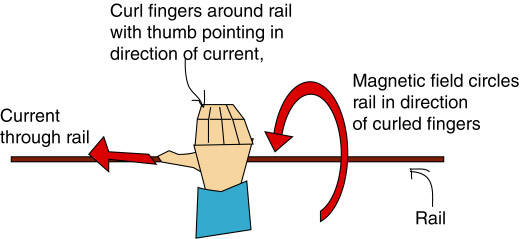An Exploration of the Physics Behind Rail Guns
Daniel Lenord
University of Alaska Fairbanks
Physics 212 Web Project, Spring 2003
Daniel Lenord
University of Alaska Fairbanks
Physics 212 Web Project, Spring 2003
| Index | Introduction | Velocity | Right Hand Rule | Bibliography | |
The right hand rule is a mnemonic for memorizing the orientation of fields,
forces, or other vector quantities after the cross product of two vector
quantities is taken. For example, the direction of the magnetic field around
a conductor due to a current can be determined by pointing the right thumb
in the direction of the current and curling the other four fingers as if
grasping the conductor. The magnetic field similarly exists as a vector
field circling the conductor in the direction indicated by your fingers.
In addition, the right hand rule comes into play when performing cross products of vector quantities. For example, when figuring out which way the projectile in a rail gun will go, you look to Equation 2. Equation 2 is truly a cross product, but presented as a simple multiplication for the sake of simplicity. The force exerted on the projectile is the cross product of scalar length L, vector i the path of the current in the projectile, and vector field B the magnetic field. When determining the direction of this force we can use the right hand rule. Since all the angles involved are 90 degrees, the resultant force has a magnitude resulting from the simple multiplication of the magnitude of i and B and the value of L. (|F|=L|i||B|) To determine the direction, lay your right hand along the path of the current through the projectile, with your fingers pointing in the direction the current is travelling. Next, curl your fingers in the direction of the B field. Your thumb will now be pointing in the direction of the applied force.

Right hand rule for magnetic field
from current through conductor
In addition, the right hand rule comes into play when performing cross products of vector quantities. For example, when figuring out which way the projectile in a rail gun will go, you look to Equation 2. Equation 2 is truly a cross product, but presented as a simple multiplication for the sake of simplicity. The force exerted on the projectile is the cross product of scalar length L, vector i the path of the current in the projectile, and vector field B the magnetic field. When determining the direction of this force we can use the right hand rule. Since all the angles involved are 90 degrees, the resultant force has a magnitude resulting from the simple multiplication of the magnitude of i and B and the value of L. (|F|=L|i||B|) To determine the direction, lay your right hand along the path of the current through the projectile, with your fingers pointing in the direction the current is travelling. Next, curl your fingers in the direction of the B field. Your thumb will now be pointing in the direction of the applied force.

Right hand rule for cross product